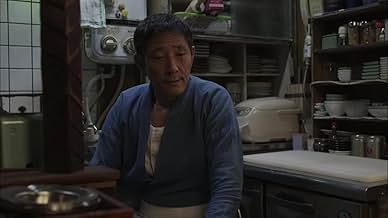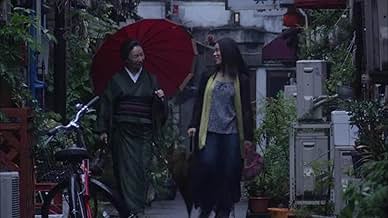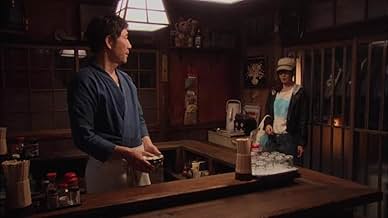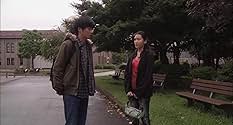अपनी भाषा में प्लॉट जोड़ेंSet in a small restaurant open only after midnight. This drama depicts the lives of the restaurant's patrons, who come for the amusing chatter and the proprietor's willingness to cook any di... सभी पढ़ेंSet in a small restaurant open only after midnight. This drama depicts the lives of the restaurant's patrons, who come for the amusing chatter and the proprietor's willingness to cook any dish they request.Set in a small restaurant open only after midnight. This drama depicts the lives of the restaurant's patrons, who come for the amusing chatter and the proprietor's willingness to cook any dish they request.
- पुरस्कार
- कुल 1 जीत
एपिसोड ब्राउज़ करें
फ़ीचर्ड समीक्षाएं
I was hooked half-way through the first episode. I saw the word "kind" in another review here and, while it's not a word one usually associates with a TV series, kindness is one of the over-arching themes of the series. Kaoru Kobayashi, the main character (everyone calls him Master) has the kind of kindness that comes from inner strength, compassion, and wisdom.
The revolving ensemble of characters is wonderful. Great casting!
Sometimes the show seems to be a comedy, other times a drama, or a melancholy tale of unrequited.
Food, the sharing of, and the making of, is a important part of the show, as well. He cooks simple food, but every dish looks delicious!
I see the series was rebooted in 2019. I hope it, too, shows up on Netflix.
50 years. Best gentle teaching of things Japanese EVER!
8mcdt
Beware, there are two shows on Netflix with a similar name. They are basically the same, but presented separately. Midnight Diner: Tokyo Stories, has two seasons from 2016 and 2019, and was commissioned by Netflix, but the original three Midnight Diner seasons ran from 2009 to 2014. I didn't know the difference at first, and couldn't understand why Netflix couldn't remember which episode I last watched, and why the characters use old cellphones in one episode and then a more advanced one in the next! Anyway, regardless of which series you watch, these slow-moving episodes are delightful as you get familiar with the culture, food, eating habits and regular customers of the restaurant dubbed the Midnight Diner, which, as the title suggests, opens at midnight. The owner, known as "Master", is willing to prepare any dish, as long as he has the ingredients. There is a short cooking summary at the end, so stay tuned until the credits. There are recurrent characters in both shows, but each episode can also be a stand-alone. The episodes are short and low-key, so you can watch it to unwind after a hectic day.
Based on a comic by Yarou Abe, Shinya Shokudo is a story about a small hole in the wall late night restaurant (literally Shinya Shokudo in Japanese) that operates between midnight and 7:00 a.m. in the morning. The restaurant is run by only one person, the master (Kaoru Kobayashi) of the joint. There are only four items on the menu Tonjiru (pork based stew), beer, sake, and shochu (potato liquor), but customers can order anything the master can make in his kitchen. The restaurant is located in the Hanazono area of Shinjuku, and has only the generic description of "Meshiya" (food place in Japanese) on its lantern.
So far 20 episodes has been on air between 2009 (the first series) and 2011 (the second series). They were all broadcast in the late night slot between midnight and 2:00 in the morning. For a late night program that are considered a "hit" if they average 1% viewers, this program consistently got over 2% ratings that attests to its popularity.
The episodes consists of life stories of customers who frequent the restaurant, but starting in the second series, each episodes consists of new customer who have their own life stories going. Because of the hours the restaurant operates, and the nature of its size, customers who frequents the place have their life in specialized areas of society that includes gangs, construction workers, lady godiva, and also part timer, fast food joint owner, salaried workers, but most of them has special background that makes the story unique and interesting.
Each episodes has particular dish that master makes that relates to the story. The list of foods on each of the episodes are as follows:
Season 1:
1. Baked Sausage and tamago yaki.
2. Bonito shavings and rice
3. Rice with tea
4. Potato salad.
5. Butter rice
6. Katsu Donburi
7. Egg sandwich
8. Yaki soba
9. Broiled Aji
10. Ramen
Season 2:
1. Baked Sausage
2. Chicken Karaage
3. Steamed clam
4. Nikogori (gelatin left from cooking fish)
5. Canned foods
6. Cream Stew
7. Pickeled Bock Choi
8. Cold ramen
9. Potato cooked with beef
10. Gyoza (Pot Stickers)
The series is superb in that it tells the story of the underbellies of the society with emotion, sentiment and love unlike any other stories told. Food designer Nami Iijima designed the foods that appear in this series, and all of these items are common items consumed by Japanese families, but not usually served in ordinary Japanese restaurants.
If you can find a copy of this drama, it will be an interesting watch guaranteed.
So far 20 episodes has been on air between 2009 (the first series) and 2011 (the second series). They were all broadcast in the late night slot between midnight and 2:00 in the morning. For a late night program that are considered a "hit" if they average 1% viewers, this program consistently got over 2% ratings that attests to its popularity.
The episodes consists of life stories of customers who frequent the restaurant, but starting in the second series, each episodes consists of new customer who have their own life stories going. Because of the hours the restaurant operates, and the nature of its size, customers who frequents the place have their life in specialized areas of society that includes gangs, construction workers, lady godiva, and also part timer, fast food joint owner, salaried workers, but most of them has special background that makes the story unique and interesting.
Each episodes has particular dish that master makes that relates to the story. The list of foods on each of the episodes are as follows:
Season 1:
1. Baked Sausage and tamago yaki.
2. Bonito shavings and rice
3. Rice with tea
4. Potato salad.
5. Butter rice
6. Katsu Donburi
7. Egg sandwich
8. Yaki soba
9. Broiled Aji
10. Ramen
Season 2:
1. Baked Sausage
2. Chicken Karaage
3. Steamed clam
4. Nikogori (gelatin left from cooking fish)
5. Canned foods
6. Cream Stew
7. Pickeled Bock Choi
8. Cold ramen
9. Potato cooked with beef
10. Gyoza (Pot Stickers)
The series is superb in that it tells the story of the underbellies of the society with emotion, sentiment and love unlike any other stories told. Food designer Nami Iijima designed the foods that appear in this series, and all of these items are common items consumed by Japanese families, but not usually served in ordinary Japanese restaurants.
If you can find a copy of this drama, it will be an interesting watch guaranteed.
I just have no language to communication the story - at all. It is drab, dry and surface deep. Well that would be it from one point of view.
For me though, i just want to say, i was broken hearted when i found out there was no more seasons - more than an other show ever!
I can't for the life of me say why.
Why would i say that, well i felt this series drum up all the naive childish experience and the craving i once had to learn how to be a human .... and crystallized it in a single series.
I can't say it is a moral endeavour but for me it was and well, better than anything else a came across in the past 20+ years. In the scope it was also revealing and heart warming. I will watch this series again more than any other over the rest of my life.
I can't speak to the potential audience in this review because there is just so many points of view, what i can do though is speak to the creators:
SO SO SO SO SO SO SO SO SO SO SO SO thank you from the bottom of my heart, this is beyond magic and had enriched my soul beyond measure. i use this series as healing..... I use it and i want you all to know that it would not be magical if the people involved were not contributors to the magic. This is one of a kind! SO SO SO SO SO SO thank you very much!!!
For me though, i just want to say, i was broken hearted when i found out there was no more seasons - more than an other show ever!
I can't for the life of me say why.
Why would i say that, well i felt this series drum up all the naive childish experience and the craving i once had to learn how to be a human .... and crystallized it in a single series.
I can't say it is a moral endeavour but for me it was and well, better than anything else a came across in the past 20+ years. In the scope it was also revealing and heart warming. I will watch this series again more than any other over the rest of my life.
I can't speak to the potential audience in this review because there is just so many points of view, what i can do though is speak to the creators:
SO SO SO SO SO SO SO SO SO SO SO SO thank you from the bottom of my heart, this is beyond magic and had enriched my soul beyond measure. i use this series as healing..... I use it and i want you all to know that it would not be magical if the people involved were not contributors to the magic. This is one of a kind! SO SO SO SO SO SO thank you very much!!!
क्या आपको पता है
- ट्रिवियाThe show was actually produced in 5 series. However, since Netflix initially only had rights to the last 2 series (4 & 5 - as a producer) they were shown under a different name, Midnight Diner: Tokyo Stories. Then, when Netflix acquired rights to the first 3 series, they were listed with a different name, Midnight Diner. However, in fact, there really is only one show, filmed continuously over the 5 series.
- कनेक्शनRemade as Shimyashikdang (2015)
टॉप पसंद
रेटिंग देने के लिए साइन-इन करें और वैयक्तिकृत सुझावों के लिए वॉचलिस्ट करें
- How many seasons does Midnight Diner have?Alexa द्वारा संचालित
विवरण
- चलने की अवधि
- 24 मि
- रंग
- पक्ष अनुपात
- 1.78 : 1
इस पेज में योगदान दें
किसी बदलाव का सुझाव दें या अनुपलब्ध कॉन्टेंट जोड़ें























